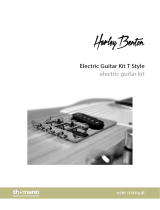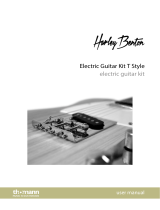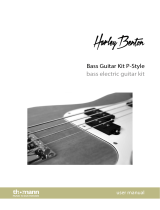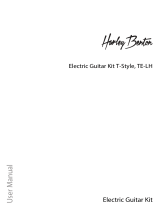Page is loading ...

®
PBK-1L
Ele
c
t
r
ic
Bass
Guitar Kit
-
PB
S
t
y
l
e
Left Handed
Assembly
Manual
Copyright © 2011 Solo Music Gear - All rights reserved

1
2
4
3
PBK-1L
Electric Bass Guitar Kit
1 - Press-fit peghead bushings (4 pcs)
2 - String Retainer (1 mounting screw included)
3 -
Neck
4 - Tuning Machines (4 pcs, 16 mounting screws included)
5 - Strings (4 pcs)
5
6 - Strap Buttons (2 pcs, 2 mounting screws included)
7 - Pickguard (12 mounting screws included)
8 - Neck Pickup (4 mounting screws included)
9 - Bridge (5 mounting screws included)
10 -
Body
11 - Neck Plate (4 mounting screws included)
12 - Ground
Wire
13 - Cord
14 - Compressible foam pad for pickups height adjustment
15 - Hex wrench for truss-rod adjustment
Copyright © 2011 Solo Music Gear - All rights reserved
6
7
11
10
8
12
13
15
9
14
6

1
PBK-1L Electric Guitar Kit
Assembly Manual
Thank you for purchasing a Solo DIY guitar kit. This unfinished guitar kit has everything for
building a PRECISION BASS® style electric bass guitar – you will need only some basic tools
and finishing supplies. All challenging wood cutting, drilling and shaping is already professionally
done, as well as fret leveling and dressing.
1. CHECKLIST
Before you start working on your DIY guitar project, please check all the parts received in this kit
use the reference drawing above. Note: This drawing is of a right handed guitar.
2. TOOLS AND MATERIALS NEEDED
You will need the following tools and materials:
1. Sand Paper (180, 240 and 320 grit)
2. Sanding Block
3. Soldering Iron & Solder
4. Masking Tape
5. Finishing Supplies
6. Screwdrivers
7. Power Drill
3. SAFETY MEASURES
Some woodworking skills are required to complete this project. Always be aware of the
necessary safety precautions and follow them – be sure to use safety glasses and a dust mask
when you are working with any tools. If you are a novice, you should look for help and guidance
of a more experienced friend. And never forget that it’s always better safe than sorry.
4. FINISHING THE BODY AND NECK
Before you start finishing the neck, please inspect the frets and the fingerboard. Even though all
wood is kiln-dried it may still shrink a little so you may get sharp fret edges.
In this case you need to use a fine needle file (Emory boards for finger nails can be used instead)
to remove all sharp edges: first make all fret edges flat with the fretboard edges on both sides,
than use masking tape on the top of the fretboard to protect it, and work on each fret’s edge to
smooth it by slightly rounding it. Before removing the masking tape, consider polishing the frets
with fine steel wool.
STEP 1 - For sanding both neck and body, use a flat sanding block for all flat surfaces and by
hand for edges and rounded/curved surfaces. Start with 180 grit sandpaper, continue with 240
and finish with 320, always moving along the grain only
. Before the final sanding, wipe the wood
with a damp cloth and let it dry to raise the wood grain. DO NOT SAND THE FINGERBOARD.

2
STEP 2 – There are many different ways to apply finish to your guitar. Do a little research to
decide which type of finish you want to use. One good starting point is to review tutorials at the
Project Guitar website: http://www.projectguitar.com/tut/tutorial5.htm
STEP 3 - For any type of spraying finish (lacquer or paint) you will need to mask three areas with
masking tape: neck pocket on the body, neck’s fingerboard and truss rod nut. Press the tape
tightly to the wood, not allowing any gaps at the edges, to completely prevent the finish leaking to
these areas.
STEP 4- You will also need to make hangers for both the body and neck (if you want to apply
any spraying finish). Make them from a strong metal wire (wire dress/coat hanger can be used for
it).
STEP 5 – Apply the finish by following the manufacturer instructions. Remember that spraying the
finish is not an easy process as it requires certain skill and experience – you might want to
practice first on some scrap wood. Always remember your safety – work only in a well ventilated
area, away from any open fire and wear a respirator mask and safety glasses.
STEP 6– Final polishing for high gloss finishes can be done manually or using a power drill with
a foam polishing pad. The finishing tools and materials are readily available in many
automotive/hardware supplies stores.
TIP: Consider an oil rubbed finish (sometimes called “wipe-on oil finish”) as a good and safe
alternative. Tru-Oil® (known as a “Gun Stock Finish”, based on Linseed Oil) or Waterlox®
(Processed Tung Oil) is highly recommended. Oil finishing takes longer, but it is very safe and
easy to apply and a high quality finish can be achieved, even by a novice.
5. ASSEMBLY
STEP 1 – Install the Machine Heads neck’s headstock. First tap in the machine head bushings into
the holes on the headstock. For tapping, you can use either a plastic headed hammer, or a regular
hammer, by placing a small piece of wood on the top of a bushing to prevent any potential
damage. You may also use a medium-sized screwdriver - slide the bushing over the shaft of the
screwdriver and then tap the handle of the screwdriver with a hammer (IMPORTANT:
firmly support
the headstock!) Next insert Machine Heads from the back and align them properly. Use a pencil to
mark the place for each screw pilot hole. Remove the tuners and connect the centers of the
corresponding marks with the straight lines. Now you are ready to put the machine heads back and
centerpunch right on the lines – this way you will ensure consistent alignment of all 4 machine
heads. For drilling the pilot holes use a right drill bit – 0.06” or 1.5mm. Be careful not to drill through
the headstock, as you need only about half way depth of the hole – better to do it slowly in two-
three shorter steps, pulling the bit out and cleaning it. Complete machine heads installation
by tightly
fastening Machine Heads with the screws.
STEP 2 - Attach the neck to the body using 4 screws with a neckplate and a setter. This step can be
performed later as you may find it easier to assemble the body without the neck.
STEP 3 – Install the bridge. First insert the ground wire (the insulation must be removed on both
ends) into the hole between the predrilled mounting screw holes and the control cavity Make sure
that enough length of bare metal wire is left on top of the body to make a secure contact with the
bridge. Now align the bridge with mounting screw holes and attach it tightly with 8 screws.
STEP 4 – Install the pickup. Insert the height
adjustment
screws into the pickup ears and put the height
adjustment
springs from the back.
Holding
the strings in place push the screws into the mounting holes and

3
roughly
adjust pickup hight.
STEP 5 –
W
ire the pickup and ground wire to the preassembled pickguard. For wiring instructions,
use the diagram on the last page of this manual.
STEP 6 - Install the Pickguard - properly align and secure it with11 screws. Do not over
tighten the screws as it can crack the pickguard.
STEP 7 – Install the Strap Buttons. If the pilot holes for the screws are missing, you will need
to
drill
them first. Find a proper spot right in the middle of the body’s depth, centerpunch and drill a
pilot hole using 3/32” (2.4mm) drill bit. Put the screw through the Strap Button then put the washer
over the screw to protect the wood of the body. Tightly secure the Strap Button.
STEP 8 – Before stringing your guitar, apply some oil to the Rosewood fingerboard to protect it
from possible shrinking and cracking. Tung oil or Linseed oil work well, or it’s OK to use
W
alnut or
Olive oil. One thin layer is enough.
W
ipe the fingerboard thoroughly with a clean cloth.
STEP 9 – Install the strings by inserting them through the holes on the back of the bridge, over the
bridge saddles. Cut the string 2 tuners longer than the tuner you are going to stick it in. On D and G
you will just have to estimate. Stick the end all the way down in the hole and bend a 90 degree. Hold
on to the string and wind it up.
STEP 10 – Now is the time to install the strings retainer. First roughly tune your bass guitar to the
pitch (see below). Reduce tension of the first (G) and the second (D) strings so that you can easily
push them towards the headstock (they should not being too loose, though), Place the retainer
between the strings beneath the 3
rd
(A) string post and push the retainer down. Next you need to
find such a place for the retainer that when pushed all the way down it will ensure the angle of the
strings a little sharper than the angle of the 3
rd
(A) string. This will result in the optimal string
pressure at the nut. When you find the right spot align the retainer between the strings so that it
visually looks like it is exactly in the middle, mark the screw place through the hole in retainer.
Remove strings, centerpunch at the mark you’ve made, drill a pilot hole and tightly secure the
retainer with a screw. Assembly is done.
6. TUNING AND SETUP
Tuning a 4-string bass guitar:
The open strings of a regular bass guitar, from the thickest to thinnest, in standard tuning are:
E (1
st
octave) – the thickest (or lowest sounding) string - is the 4th string
A (1
st
octave) – is the 3rd
D (2
nd
octave) – is the 2nd
G (2
nd
octave) – the thinnest (or highest sounding) is the 1
st
string.
There are different methods to tune a guitar. Using a digital tuner is the easiest way. However, it
is good to learn tuning (and checking the accuracy of tuning) by ear with natural harmonics,
unisons, octaves etc.

4
Guitar playability and intonation depends on its setup, so you may want to spend some time
mastering the necessary skills – be persistent in finding the optimal action (string height), neck
relief and intonation throughout the entire neck.
Adjusting Strings Height:
String height is adjusted by the bridge saddle screws (use included Allen key). Since the
fretboard has a radius, the heights of all strings should also match it. Thicker strings need more
room for vibration without “buzzing” (touching frets) and must be set up higher than thinner
strings. Low action allows easier fretting and faster playing. Recommended measurements for
electric bass guitar with low action:
For the 1
st
String (the thinnest) – height at the 1st fret: 0.020” – 0.024” (0.5 – 0.6mm);
at the 12
th
fret: .094” – .1” (2.4 – 2.6mm).
For the4
th
String (the thickest) – height at the 1st fret: 0.022” – 0.025” (0.55 – 0.64mm);
at the 12
th
fret: .094” – .0110” (2.6 – 2.8mm).
The height at the first fret can be adjusted by cutting deeper slots for strings at the nut.
However, it needs a very precise job not to spoil the nut. If you are not sure that you can
do it properly, stay with a factory pre-cut nut.
A higher string action makes the guitar harder to play, yet some musicians may prefer it.
Adjusting Neck Relief:
The truss rod compensates for string tension and allows adjusting the neck relief. You may need
such adjustment due to changes of humidity and temperature (or if you switch strings to a
different gauge). Lay a straight edge on the frets of a properly tuned guitar and measure the
clearance at the 8
th
fret (alternatively you can put a capo on the first fret and press down 6th
string at 16
th
fret – then the height of the string at the 8
th
fret will show you the
clearance).
Optimal
relief for an electric guitar neck must be very small – around .014”- 024” (0.35 - 0.6mm). Turning
the truss rod nut (with the included Allen key) clockwise will reduce neck relief and turning it
counterclockwise will increase the relief. Be very careful with truss rod adjustments and never
turn the nut more than ¼ of a turn at a time.
Adjusting Intonation:
The “speaking length” (or “working length”) of each string can be adjusted by turning the saddle
position adjustment screw. The best intonation can be achieved when the string fretted at the 12
fret sounds precisely an octave higher than the open string. If the fretted string sounds
sharper
you
need to increase the working length of the string by moving the saddle away from the neck. If
it sounds flat, you need to shorten the working length of the string by moving the saddle towards
the neck. The alternative way to intonate your guitar is to compare a natural octave harmonic of
the open string (you can get it by touching the string exactly above the 12
th
and picking it) to the
pitch of the string fretted at the 12
th
fret and adjusting the saddle position so that they sound the
same. This method is less accurate because the fretted string sounds a bit sharper due to the
height of the string, and the higher the action, the sharper it gets.
Adjusting the Pickup Height:
Before adjusting the pickup height, make sure that both the volume and tone controls on your
bass are set to the full (“10”) position. Get your amp set to a medium/low volume and all tone
controls to the middle. You will get a better picture of the pickup’s tone change during its height

adjustment with a clear sound.
There is no universal “optimal” pickup height position in a setup – it depends on playing style and
personal preferences of a bass player. Remember: bringing a pickup closer to the strings
makes it
sound brighter, but bringing it too close will make the magnetic field of the pickup interfere with
the vibration of a string which will, not only result in reduced sustain, but may also cause complex
harmonics sound rather unpleasant. Moving a pickup too far from the strings will result in loss
of
its
output signal and some higher frequencies. It’s not necessary to maintain an even height of
the pickup – you may find it more
satisfactory
sounding by setting it somewhat angled, depending
on what you are looking for in the output sound.
There are a few mm of real usable range where you can find the pickup tone that you’ll like the
best.
IMPORTANT: W
hen you have your guitar finished, please take a few pictures
and send them to us for potential posting into the picture gallery on our website.
Email it in a JPG format to mysolo@solomusicgear.com
© 2011, Solo Music Gear
PRECISION BASS® is a registered trademark of Fender Musical Instruments Corp. Solo Music
Gear is not affiliated with Fender in any way.
5

PU
Hot
wire
PU Ground
wire
Ground
wire to the bridge
Solo PBK-1 Wiring
Diagram
Copyright © 2011 Solo Music Gear - All rights reserved
/



